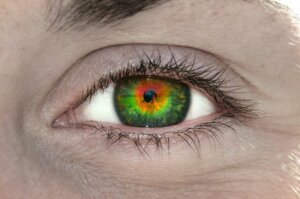What Is Tetrachromacy and What Does It Mean?


Written and verified by the doctor Leonardo Biolatto
Tetrachromacy is a condition that makes lots of scientists curious. It’s a term that refers to a visual quality, which is that people or animals with it have a greatly increased vision index.
In fact, they can see up to 100 million colors. Tetrachromacy exists in certain animals, like some birds, fish, insects, and amphibians. In fact, some humans can have it, too!
How is color vision produced?
Before explaining what tetrachromacy consists of, it’s important to have some basic idea about how the vision process occurs. The retina is a light-sensitive tissue at the back of the eyeball.
It’s made up of different cells that have rods and cones. They are light-sensitive cells. The cones let us see colors, which is chromatic vision.
There are different types of cones depending on how they react to light. Most of the human population has three types. Each of them reacts to light with different bandwidth. Then, information travels through the optic nerve to the cerebral cortex.
Therefore, most people have trichromatic vision. One type of cone detects red light, another type blue light, and a third type green light. In this way, you can see almost 1 million colors.
However, something different happens in some types of animals. For example, some fish actually have a fourth type of cone that lets them perceive variations for each of the colors.

What is tetrachromacy?
Tetrachromacy is a visual condition that allows you to capture about a hundred times more colors than usual. It’s estimated that almost 12% of all women in the world have this characteristic.
What happens is that they have a fourth type of cone. These people are called tetrachromats. That fourth cone allows them to obtain a four-dimensional sensory color space. That is, they have a much larger visible spectrum, since they can combine more primary colors.
On the other hand, the rest of the people can only make combinations with three colors- red, green, and blue. They are called trichromats. This means that they can’t see all possible variants.
You may be interested in: Tips to Prevent Dry Eye Symptoms Due to Screen Use
How is it different from the other categories?
Right now, we know of different types of vision, depending on the cones in the retina. The first is trichromatism. In fact, this is the most common form of vision in humans.
However, vision can also be dichromatic. It’s the most common type in animals, like dogs. They are only sensitive to blue and green cones. Finally, there is tetrachromacy.
Specifically, distinguishing whether a person has trichromatism or tetrachromacy is difficult. Sometimes, you can only tell with a biopsy of the retinal tissue.
What causes tetrachromacy?
Apparently, this condition is almost exclusive to women. This is because it’s a variation of the X chromosome, where the dichromatic gene is.
The genes responsible for expressing the red and green cones are in this chromosome. Therefore, there are more in women because they have two X chromosomes while men only have 1.
This way, they are more likely to have two different versions of those genes. So, they would express four types of cones. However, this doesn’t mean that there can’t be men with tetrachromacy.
You might be interested in: Everything You Need to Know about Visual Impairment
How can it be identified?
To date, there isn’t a test that reliably diagnoses tetrachromacy. Online tests that try to verify this condition aren’t scientifically proven to work.
This is because they’re made on digital screens that are based on RBG technologies. In other words, they’re made with a trichromatic color representation system. However, scientists are trying to make accurate tools to diagnose it.
On the other hand, there’s a way to diagnose tetrachromacy with certainty, but it’s complex. To do it, you need to get a retinal sample. These types of biopsies are very difficult to perform since they involve many risks for the patient’s eyesight.

Tetrachromacy is more common than you think
Tetrachromacy is a visual condition that some women have in particular. It consists of having one more type of cone, which are the retina cells in charge of color vision. Normally, there are three different varieties, but these people have four.
As a result, they can see almost a hundred times more colors than usual. However, as of today, there are no established methods to diagnose the condition.
All cited sources were thoroughly reviewed by our team to ensure their quality, reliability, currency, and validity. The bibliography of this article was considered reliable and of academic or scientific accuracy.
- Hugues, B., et al. “La visión cromática en los animales.” REDVET. Revista Electrónica de Veterinaria 9.11 (2008): 1-6.
- Coria Cancelo, Guillermo. “La visión del color en los seres humanos.” (2015).
This text is provided for informational purposes only and does not replace consultation with a professional. If in doubt, consult your specialist.








